What is the 2-1-2 zone defense in basketball
The 2-1-2 zone defense is a basketball defensive strategy that seeks to limit dribble penetration, influence contested perimeter jump shots, and reduce offensive scoring opportunities, particularly from the low post areas, while executing adequate on-ball defense.
Also, there is a variation known as the 2-1-2 match-up zone defense. It’s primary objective is to provide a greater amount of defensive pressure against any player with the ball, particularly near the top, wing, or corner areas of the court.
Furthermore, in the 2-1-2 match-up variation, the defense will emphasize ball denial, especially near the wings, corners, and/or high post areas.
What is an example of the initial formation for the 2-1-2 zone defense
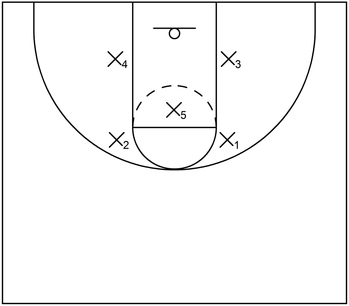
This is an example of the initial formation for the 2-1-2 zone defense. It consists of two defenders at the front of the zone, one defender in the middle of the zone, and two defenders in the back of the zone.
Additionally, each of the zone defenders will cover certain areas of the court. X1 and X2 start near the high post elbow areas. X5 starts slightly below the free throw line in the key while X3 and X4 start near the low post blocks.
What are the general responsibilities of the defenders within the 2-1-2 zone defense
The typical responsibilities of X1 and X2 are to cover the high post and the wing areas. The general responsibilities of X3 and X4 are to cover the strong side corners and the weak side low post areas.
Additionally, X3 and X4 could also double team the low post or temporarily cover the wing areas in some instances. The primary responsibilities of X5 are to execute low post defense and protect the basket.
What are advantages of the 2-1-2 zone defense
One convenient advantage of the 2-1-2 zone defense is that it could present a scoring challenge for offensive teams with below average perimeter shooters.
Another particular advantage is that it could cause an offensive disruption for teams that prefer to run their offense through the high posts because those areas are typically always covered by at least one zone defender.
What are disadvantages of the 2-1-2 zone defense
A noteworthy disadvantage of the 2-1-2 zone defense is that it is susceptible to perimeter ball reversal by the offensive team.
Another notable weakness is that the 2-1-2 zone defense could be rendered ineffective if the offensive team has at least one or two players that can shoot three-pointers, specifically from the wings or corners.
What are general principles to consider for the 2-1-2 zone defense
Limit or prevent low post touches
If the ball gets into the hands of a low post player with above average offensive skills, then that player could score quickly and efficiently against the nearest zone defender with a low post move.
Therefore, the defenders near the back of the zone could alleviate this problem by standing in the gap between the low post area and the wing/corner.
This will increase the difficulty for the offensive team to make an easy entry pass to the low post player.
In addition to that, if the ball does happen to get into the low post, then two of the zone defenders could execute a double team, which could influence the low post player to pass the ball back out towards the perimeter.
Use bumping during ball reversal
As mentioned previously, one of the primary disadvantages of the 2-1-2 zone defense is its susceptibility to perimeter ball reversal. However, the zone defenders could mitigate this problem to a degree by executing a technique known as bumping.
Essentially, when the ball gets reversed from wing to wing, one of the defenders in the front of the zone that typically covers the wing will usually not have enough time to recover.
If that happens, then it could lead to wide open perimeter jump shots or possible dribble penetration into the zone.
However, to counter those potential actions by the offensive team, one of the defenders in the back of the zone will step up towards the wing to temporarily cover that area.
Afterwards, the zone defender that is assigned to the wing area will bump the zone defender that temporarily covered that area to the back of the zone.
Limit or prevent uncontested jump shots
One of the main points of the 2-1-2 zone, like most zone defenses, is to influence perimeter jump shots. Nevertheless, this does not automatically mean that offensive players should be able to freely take uncontested jump shots.
Instead, the defenders of the 2-1-2 zone defense should always try to execute defensive closeouts with good footwork and contest jump shots, even from below average shooters.
This is especially important for the defenders near the back of the zone. These particular zone defenders should emphasize executing good closeouts to prevent open jump shots and/or limit dribble penetration, especially during ball reversal.
What are examples of defensive rotations for the 2-1-2 zone defense
Example 1

This is an example of the 2-1-2 zone defense when the basketball is at the top. X1 and X2 cover the high post areas while X3 and X4 cover the low post areas. Also, X5 covers the middle area within the lane slightly below the free throw line.
Example 2

This is an example of the 2-1-2 zone defense when the ball is on the wing. X1 slides over to cover 2 while X2 slides over to cover the high post and deny the potential entry pass.
Also, X3 slides over a bit to stand in the gap between the wing and the corner. At the same time, X4 covers the weak side low post area.
Additionally, X5 drops back to cover the low post player and could front the low post as well.
Example 3

This is an example of the 2-1-2 zone defense when the ball is in the corner. X3 executes a defensive closeout to prevent an open jump shot or dribble penetration.
Additionally, X1 covers the wing while X2 covers the high post. X4 continues to cover the weak side low post while X5 continues to guard the low post player.
Example 4
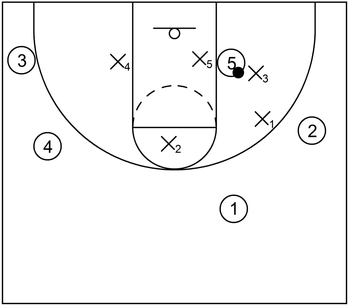
This is an example of the 2-1-2 zone defense when the ball gets into the low post. X5 executes solid low post defense without fouling. Additionally, if there is an empty corner, then X3 could immediately double the post with X5.
If there is not an empty corner, then X1 could execute the double team action instead, assuming that 2 would be a below average perimeter shooter.
X2 continues to cover the high post while X4 continues to cover the weak side low post area.
Example 5
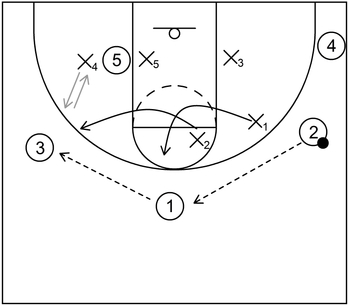
This is an example of the 2-1-2 zone defense when the ball gets reversed from the right side wing to the left side wing. So, 1 receives the ball from 2 and then 3 receives the ball from 1.
When that occurs, X2 will probably not have enough time to shift from the high post to the left side wing.
Therefore, X4 alleviates this issue by moving to the front of the zone from the back area, mainly to temporarily guard the player in possession of the ball.
Afterwards, X2 should recover to the ball and bump X4 back to the original spot, represented by the gray arrows.
Additionally, X1 cuts to the high post area while X3 covers the weak side low post area. Also, X5 continues to guard the low post player, except this time, on the opposite side of the court.
Example 6
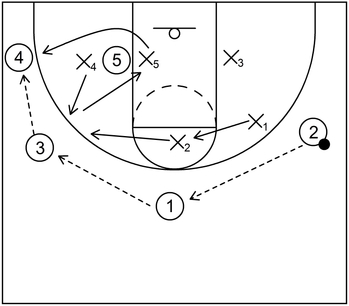
This is another example of ball reversal within the 2-1-2 zone defense. However, this time, the offensive team has overloaded the left side of the floor. So, the action starts similar to the previous diagram with 1 receiving the ball from 2 and then 3 receiving from 1.
Afterwards, X4 proceeds to temporarily closeout on 3 until X2 recovers and bumps X4 to the back of the zone.
However, when that occurs, X4 would not have enough time to recover to the left side corner if 4 receives the ball from 3. Therefore, to mitigate this issue, X5 will temporarily closeout on 4 if 4 were to receive the ball from 3.
Example 7
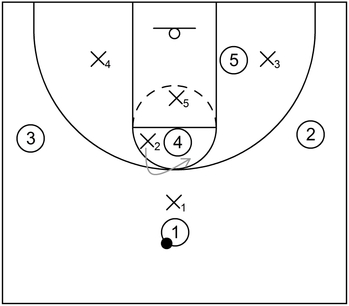
This is an example of the 2-1-2 match-up zone defense when the ball is at the top. One of the two top defenders will step out beyond the three-point arc to apply defensive pressure to the ball handler.
Usually, the defender that applies initial pressure is one of the best perimeter defenders on the team and could also have above average speed and the ability to generate steals or deflections.
For this example, that defender is X1. Also, the other top defender X2 should cover the high post area and deny any entry passes to the high post player as represented by the gray arrow.
Example 8
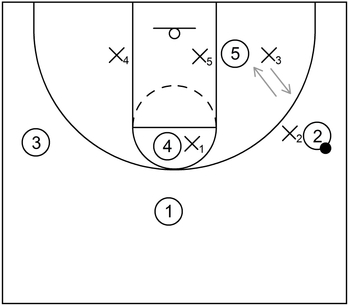
This is an example of the 2-1-2 match-up zone defense when the ball is on the wing. 2 receives the ball near the wing and when that occurs, X3 could temporarily guards the right side wing until X2 recovers and bumps.
Afterwards, X2 should pressure the ball as much as possible without fouling. Also, X1 drops back to deny any high post entry passes to 4 while X5 guards the low post player. Additionally, X4 covers the weak side area.
Example 9
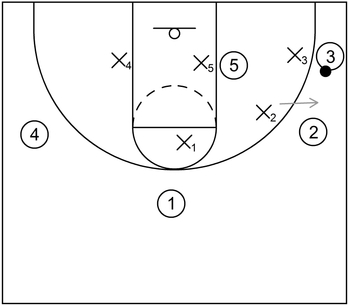
This is an example of the 2-1-2 match-up zone defense when the ball is in the corner. X3 executes a defensive closeout to prevent an open jump shot or dribble penetration.
Additionally, X2 has the option to execute denial defense (shown with the gray arrow) with a hand in the passing lane to prevent the easy pass back towards the wing.
X1 continues to cover the high post area while X5 continues to cover the low post. Furthermore, X4 continues to cover the weak side area as well.